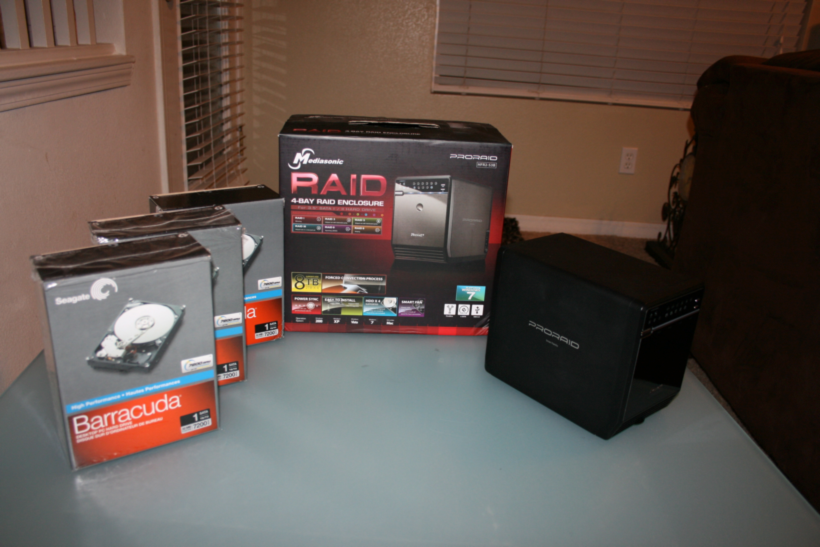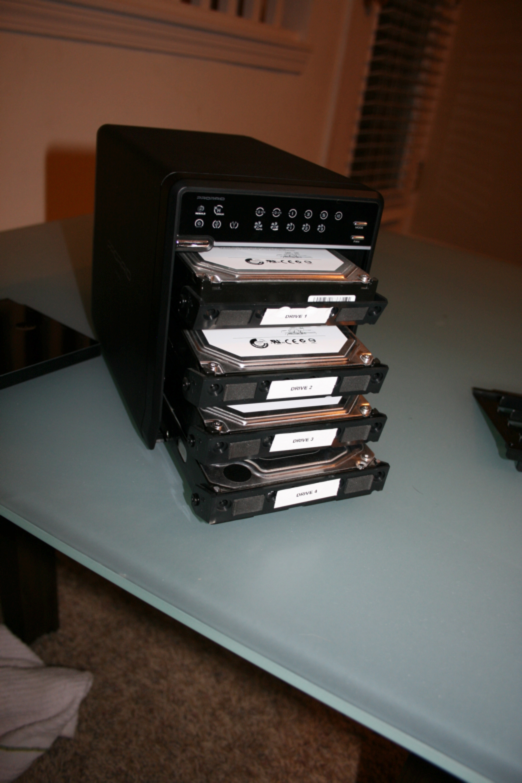Anyone who has lost days of work or priceless photo albums due to a system crash knows the value of data redundancy. In this day and age where hard drives die without notice, redundancy of data is a must. To have a hard drive professionally recovered from a company like Gillware.com it will cost you between $450.00-$1500.00+. Setting up your own in home or office Raid array is the best solution to maintain your invaluable data. The ProRaid Raid Enclosure from Mediasonc is a Raid array setup that is not harsh on the pocket book. There are many companies that offer Raid or hard drive enclosures but they often come with hefty price tags. This is definitely not the case with the ProRaid. With a MSRP of $219.00 or even less if you run a quick Google search. The ProRaid comes in at fraction of the price from most other enclosures.
The build quality is the first thing that I noticed out of the box. It is remarkable; I was expecting an inferior enclosure because of the price. The entire body is aluminum & very sturdy. This could easily be priced twice as much. The enclosure includes all cables that you may want to use. This also surprised me. There is a USB, eSATA, FireWire 400 and FireWire 800 cable included in the box. Usually you have to drive out to Best Buy and spend an extra $20 to get a eSATA or FireWire 800 cable. The hard drives are easily removed and replaced with a plastic eject piece that is installed on each drive before you insert them into the enclosure. The fan has 3 speeds with a temperature sensor for auto mode. On high, the drives remained cool to the touch even while transferring files continuously for over 8 hours.
This enclosure offers many Raid options:
-Raid 0 Spanning – This concatenates multiple hard drives as a single large volume.
-Raid 0 Striping – This writes data across multiple drives simultaneously which increase the performance of disk reads. This Raid is not good for redundancy as one drive is lost all data is lost.
-Raid 1 – Mirroring – If one drive fails the data has redundancy on the mirrored drive. The downfall to this Raid it that you are only able to use the full potential of half the drives. The other drives are used as a mirror.
-Raid 3 – Striped set with dedicated parity – With this Raid there is one drive used for parity so if a drive fails that is not the parity drive the data is still recoverable. The downfall to this Raid is that the parity drive is a speed bottleneck for writing because every write requires updating. You lose one drives data space for parity.
-Raid 5 – Spanning ModeStriped set with distributed parity – This Raid uses striping across all the drives for parity. This Raid will work even if one of the drives fails. The downfall to this Raid is that if 2 drives fail simultaneously then you loose all data. (This Raid is the setup that I use.)
Raid 10 – Mirroring and Striping – With this Raid you will have two drives that are striped together and a mirrored set that are also striped.
I used 4 Seagate Barracuda 1TB hard drives in the enclosure running Raid 5. With this setup I am able to use 3 terabytes. The enclosure does max out at 2 terabytes per drive, so your maximum space that you can achieve is 8TB on Raid 0 or 6TB on Raid 5. I did fall victim to a failed drive and got to experience the good that the PRORAID serves. The drive replacement process was very easy. An error light flashes on the front panel to notify you to check the drives you then click open the front panel and see which drive has failed. There is a led next to each drive, which will light red if there is an error. I slid the hard drive out and slid a new one in. The rebuild process then begins to restripe the data back onto the drive. The rebuild process can take quite a while but the good thing is that hard drives are still functional during the process. I found the read & write speeds were a bit slower during this process but that is to be expected. The enclosure has multiple cable connector types, 1 – eSATA, 1 – USB, 1- FireWire 400 and 2 – FireWire 800. The enclosure is compatible with Mac and PC.
Here are some benchmarks that I ran with Disk Speed Bench X:
Raid enclosure – Elapsed time 6.030099 secs; transfer speed (89031858bytes/sec)
Mac’s SATA drive – Elapsed time 4.941951 secs; transfer speed (108635417bytes/sec)
External USB drive – Elapsed time 50.161065 secs; transfer speed (10702941bytes/sec)
I have the enclosure running over FireWire 800 to my iMac and it is very fast. Almost 9 times faster that running the same speed SATA drive over USB. You wont really find any hang-ups on drive speed especially if you have a free FireWire 800 or eSATA port to use with this.
The ProRaid from Mediasonic is for those that want a great data redundancy solution at a price that is perfect for home use. Prices for this setup came in at just over $400 shipped. PRORAID enclosure $169.00 shipped from Amazon. Four Seagate Barracuda 1TB drives from newegg.com at $59.99 each.

